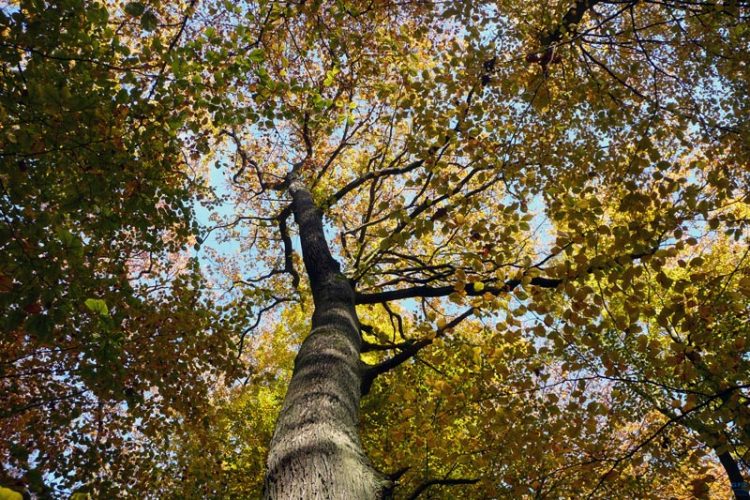The influence of increased atmospheric CO2 concentration on European trees

Tops of broadleaf trees (Photo: I. Heinrich, GFZ)
Increased atmospheric CO2 concentrations have already caused large-scale physiological responses of European forests. In particular, the efficiency of water-use of trees, which is coupled to the uptake of CO2 during photosynthesis of leaves and needles has changed significantly. According to the study of a large, interdisciplinary team of researchers, European broadleaf and coniferous trees have increased their water-use efficiency since the beginning of the 20th century by 14% and 22%, respectively.
During photosynthesis trees take up carbon dioxide (CO2) from the air. In return they loose water vapor (H2O) through tiny pores of their leaves or needles, so-called stomata.
This gas exchange between trees and the atmosphere is regulated through the opening widths (aperture) of their stomata. Wider apertures of the stomata allow the uptake of higher numbers of CO2 molecules, but promote an increased loss of water vapor (transpiration) into the atmosphere. The opposite holds for narrowed stomatal apertures.
“Assuming that the trees demand for CO2 does not change, they can reduce the aperture of the stomates of their leaves and needles under increasing atmospheric CO2 concentrations.
This should lower the rates of transpiration and minimize the tree’s water loss”, says Gerhard Helle at the GFZ German Research Centre for Geosciences, co-author of the study. “Nevertheless, a 5% increase in European forest transpiration was calculated over the twentieth century. This can likely be attributed to a lengthened growing season, increased transpiration due to a warmer environment, and an enhanced leaf area.”
The results are important for better estimates of the impact of forests on climate, improved model scenarios of future climate development and more reliable assessment of the global water cycle.
Furthermore, ecological consequences might evolve because of the significantly different responses to increased atmospheric CO2 of broadleaf and needleleafed species.
The data set utilized in this study has been established from a tree-ring based network (ISONET) funded by the EU that aims at the analysis of carbon isotope ratios (13C/12C). ISONET was initiated and coordinated by GFZ-scientists Gerhard H. Schleser (presently also FZ-Jülich) and Gerhard Helle.
D. C. Frank et al.,: „Water-use effciency and transpiration across European forests during the Anthropocene”, NATURE CLIMATE CHANGE, VOL. 5, MAY 2015, DOI: 10.1038/NCLIMATE2614
Media Contact
More Information:
http://www.gfz-potsdam.de/All latest news from the category: Earth Sciences
Earth Sciences (also referred to as Geosciences), which deals with basic issues surrounding our planet, plays a vital role in the area of energy and raw materials supply.
Earth Sciences comprises subjects such as geology, geography, geological informatics, paleontology, mineralogy, petrography, crystallography, geophysics, geodesy, glaciology, cartography, photogrammetry, meteorology and seismology, early-warning systems, earthquake research and polar research.
Newest articles

Superradiant atoms could push the boundaries of how precisely time can be measured
Superradiant atoms can help us measure time more precisely than ever. In a new study, researchers from the University of Copenhagen present a new method for measuring the time interval,…

Ion thermoelectric conversion devices for near room temperature
The electrode sheet of the thermoelectric device consists of ionic hydrogel, which is sandwiched between the electrodes to form, and the Prussian blue on the electrode undergoes a redox reaction…

Zap Energy achieves 37-million-degree temperatures in a compact device
New publication reports record electron temperatures for a small-scale, sheared-flow-stabilized Z-pinch fusion device. In the nine decades since humans first produced fusion reactions, only a few fusion technologies have demonstrated…





















